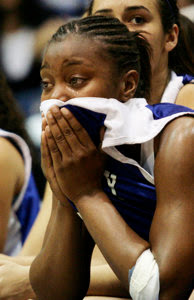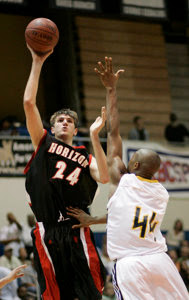Sunday
Mar182007
Making the Best in Bad Light
 Sunday, March 18, 2007 at 10:37PM
Sunday, March 18, 2007 at 10:37PM  This weekend I was assigned to shoot high school basketball. It doesn't have the glamor of the NBA, but it is less restrictive and you are more likely to get a great photo than from a pro game.
This weekend I was assigned to shoot high school basketball. It doesn't have the glamor of the NBA, but it is less restrictive and you are more likely to get a great photo than from a pro game.The first thing was to plan on what gear to bring. I usually bring a couple of camera bodies with a 70-200mm 2.8 lens, 16-35mm 2.8 zoom and my 300mm f2.8 lens and call it a day. But that's for a professional or major college team in a well-lit arena. High school is a different manner. Most high school games are played in dark dingy gyms. So my first thought was to bring in some portable strobes with wireless pocket wizards to trigger them.
Then I realized since this was a regional final game to played at Cal State Fullerton, a college gym, I didn't think I needed to bring in additional lighting. I needed just a few action photos and some reaction photos of players either celebrating or sitting on the bench in dejection if
 they lose.
they lose.I brought a couple of fast primes, my 50mm f1.4 and my 85mm f1.8 lens just in case the light was bad.
The first thing I realized when I stepped into the gym was that it was dark. Very dark. At that point I second guessed not bringing in some strobes. My camera exposure said f1.8 at 1/500th of second at iso 1600 under the basket. You need to shoot at least 1/500th of second to stop basketball action and iso 1600 is the highest my camera will shoot at, the 3200 setting is unusable. The 1600 setting is really pushing it.
For reaction shots 1/250th second shutter speed would be okay with my f2.8 lenses. So I decided my 16-35mm and 70-200mm lenses would be for post-game shots. And try to get some action on the 85mm f1.8 lens during the game.
 I noticed there was an area high up on the second level where I could also take some photos. Might as well walk around the gym and try to get some different angles, something that isn't allowed in an NBA game. Shooting overhead also allows you to shoot with a better exposure as the light is reflected directly back to you, giving you about a 1/3 stop of light. So why not?
I noticed there was an area high up on the second level where I could also take some photos. Might as well walk around the gym and try to get some different angles, something that isn't allowed in an NBA game. Shooting overhead also allows you to shoot with a better exposure as the light is reflected directly back to you, giving you about a 1/3 stop of light. So why not?Both the teams I was covering lost, giving me only the opportunity to shoot photos of crying kids at the end. Emotions run very high during a high school play-off game, another thing you won't typically get during an NBA game.
In the end, my client got a range of photos in different shapes to fit their layouts and made a very short deadline. I got them photos in less than ten minutes after the game ended.






Reader Comments